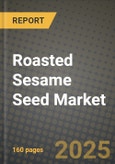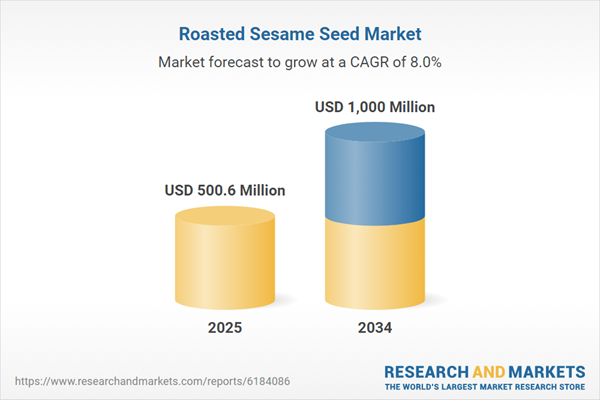Roasted Sesame Seed Market
The roasted sesame seed market sits at the intersection of health-forward snacking, globalized cuisines, and value-added condiments. Roasted seeds - white, black, and golden; hulled and unhulled - are used widely in bakery toppings (buns, breads, crackers), confectionery and savory coatings (bars, brittle, candy shells, katsu/fried crumbs), meal kits and ready meals, sushi and poke, noodle sachets, salad dressings, furikake/gomashio blends, tahini-based applications, and premium snack mixes. Recent trends favor clean-label, minimally processed ingredients; single-origin storytelling; organic and non-GMO lines; steam-sterilized, low-pathogen specifications; and flavored variants (honey-roasted, chili-garlic, yuzu, truffle). Demand is reinforced by plant-based eating, protein-dense snacks, and the mainstreaming of Japanese, Korean, Middle Eastern, and Southeast Asian formats across retail and foodservice. On the supply side, the market navigates climate-sensitive harvests and origin diversification, with processors investing in contract farming, residue control, color sorting, continuous drum/infrared roasting, and high-bar food-safety certifications (HACCP, BRCGS, FSSC). Packaging advances - nitrogen-flushed pouches, PET jars, and recyclable multilayer films - extend shelf life and reduce rancidity risk while enabling e-commerce and private-label growth. Competitive intensity remains high: regional SMEs and specialty importers sit alongside integrated seed-to-shelf players and co-packers serving bakery, QSR, and meal-kit accounts. Differentiation increasingly hinges on consistent roast profiles, micro-spec control (moisture, breakage, foreign matter), allergen management, traceability, and culinary innovation. Channel dynamics are shifting toward omnichannel merchandising, with foodservice recovery and retail snack aisles both supporting premiumization in roasted, flavored, and mixed-seed propositions.Roasted Sesame Seed Market Key Insights
- Culinary mainstreaming fuels baseline demand. The adoption of Asian and Middle Eastern flavors in retail meal kits, QSR toppings, and grocery condiments continues to expand usage occasions from bakery into center-store and fresh perimeter, stabilizing year-round pull and supporting premium roasts and blends.
- Product forms drive margin mix. Whole hulled white seeds dominate bakery and dressing applications; black seeds deliver visual premium cues; unhulled seeds and crushed/kibble formats serve coatings and snack clusters - each with distinct price realization and waste/yield profiles across roasting lines.
- Food-safety and residue control are decisive. Buyers prioritize steam sterilization, validated kill-steps, and tight pesticide-residue management; suppliers winning large tenders lead with certifications, allergen controls, and repeatable low-micro specs tied to origin programs.
- Flavor innovation expands price ladders. Honey-roasted, chili, wasabi, maple, truffle, and sesame-oil-infused variants unlock higher unit economics, particularly in stand-up pouches and gourmet toppers positioned for salads, ramen, poke, and bakery kits.
- Private label scales quickly. Retailers extend store brands into toasted toppers and seasoning blends; success depends on consistent roast color, low breakage, and rapid new-flavor development supported by agile co-packing.
- E-commerce reshapes pack/price architecture. Growth in direct-to-consumer and marketplace channels favors resealable pouches, trial bundles, and chef-size formats; conversion hinges on product photography, origin stories, and verified clean-label claims.
- Origin diversification mitigates volatility. Blending strategies and multi-origin sourcing cushions weather and logistics shocks; processors with contract farming and in-house cleaning/sorting reduce quality variance and lead-time risk.
- Regulatory shifts raise compliance stakes. Allergen labeling requirements and tightening MRLs elevate documentation and testing burdens; vendors with digital traceability and batch-level COAs shorten audits and speed approvals.
- Operational excellence wins repeat business. Continuous drum or infrared roasting, inline color sorting, optical foreign-matter control, and nitrogen flushing improve shelf life and flavor stability, cutting returns and protecting brand equity.
- Foodservice rebound lifts volume tiers. QSR, bakery chains, and sushi/poke concepts re-accelerate bulk demand in multi-kilogram formats; menu innovation (spicy toppers, mixed-seed crusts) sustains throughput and supports stable plant utilization.
Roasted Sesame Seed Market Reginal Analysis
North America
Demand is propelled by the penetration of sushi, poke, ramen, and Mediterranean concepts, plus premium salad and bakery toppings. Retailers expand private-label roasted and flavored variants, while allergen labeling and residue compliance heighten vendor qualification. Foodservice rediscovery of crunchy, visual toppings benefits bulk roasted and mixed-seed SKUs. Omnichannel brands leverage storytelling around origin, roast profile, and clean-label positioning.Europe
Artisan and industrial bakeries remain anchor users, with steady uptake in salad dressings, snack mixes, and vegan convenience. Buyers emphasize organic certification, low-residue specs, and sustainability narratives. Northern and Western markets favor private label and discounter expansion; Southern markets lean into Mediterranean formats. Traceability, ethical sourcing, and recyclable packaging are strong differentiators in retailer tenders.Asia-Pacific
The core consumption base - Japan, Korea, China, and Southeast Asia - drives specification-heavy demand for precise roast levels and black/white seed aesthetics in noodles, confectionery, furikake, and bakery. Domestic processors invest in automated roasting, color sorting, and steam sterilization. Export-oriented players supply flavored toppers for regional QSRs and global retailers, with e-commerce accelerating premium pack sizes.Middle East & Africa
Sesame-rich culinary traditions support resilient baseline usage across bakery, confectionery, and tahini-influenced applications. Origin proximity for several African producers aids supply optionality, while regional processors increasingly adopt higher food-safety standards to serve modern retail. Branding around heritage, purity, and minimal processing resonates; logistics reliability remains a key buyer criterion.South & Central America
Growth stems from modern retail adoption of international cuisines, bakery toppings, and salad accents. Import-reliant markets prioritize stable supply partnerships and compliance documentation. Emerging local roasters position flavored toppers and snack mixes for health-conscious consumers, while foodservice chains gradually introduce sesame-forward menu items, lifting demand for bulk roasted formats.Roasted Sesame Seed Market Segmentation
By Type
- White Roasted Sesame Seed
- Dark Roasted Sesame Seed
By Application
- Food Application
- Feed Application
- Others
Key Market players
Kadoya Sesame Mills, Kuki Sangyo Co., Ltd., Takemoto Oil & Fat Co., Ltd., The Nisshin OilliO Group, Ltd., Ottogi Co., Ltd., CJ CheilJedang, ofi (Olam Food Ingredients), Wilmar International Limited, COFCO Corporation, Dipasa Group, Sesajal S.A. de C.V., Selet Hulling PLC, Export Trading Group (ETG), WACOT Limited, Flavor Full Foods Inc., Roland Foods LLC, Eden Foods Inc., Kevala, McCormick & Company, Dhaval Agri Export LLPRoasted Sesame Seed Market Analytics
The report employs rigorous tools, including Porter’s Five Forces, value chain mapping, and scenario-based modelling, to assess supply-demand dynamics. Cross-sector influences from parent, derived, and substitute markets are evaluated to identify risks and opportunities. Trade and pricing analytics provide an up-to-date view of international flows, including leading exporters, importers, and regional price trends.Macroeconomic indicators, policy frameworks such as carbon pricing and energy security strategies, and evolving consumer behaviour are considered in forecasting scenarios. Recent deal flows, partnerships, and technology innovations are incorporated to assess their impact on future market performance.
Roasted Sesame Seed Market Competitive Intelligence
The competitive landscape is mapped through proprietary frameworks, profiling leading companies with details on business models, product portfolios, financial performance, and strategic initiatives. Key developments such as mergers & acquisitions, technology collaborations, investment inflows, and regional expansions are analyzed for their competitive impact. The report also identifies emerging players and innovative startups contributing to market disruption.Regional insights highlight the most promising investment destinations, regulatory landscapes, and evolving partnerships across energy and industrial corridors.
Countries Covered
- North America - Roasted Sesame Seed market data and outlook to 2034
- United States
- Canada
- Mexico
- Europe - Roasted Sesame Seed market data and outlook to 2034
- Germany
- United Kingdom
- France
- Italy
- Spain
- BeNeLux
- Russia
- Sweden
- Asia-Pacific - Roasted Sesame Seed market data and outlook to 2034
- China
- Japan
- India
- South Korea
- Australia
- Indonesia
- Malaysia
- Vietnam
- Middle East and Africa - Roasted Sesame Seed market data and outlook to 2034
- Saudi Arabia
- South Africa
- Iran
- UAE
- Egypt
- South and Central America - Roasted Sesame Seed market data and outlook to 2034
- Brazil
- Argentina
- Chile
- Peru
Research Methodology
This study combines primary inputs from industry experts across the Roasted Sesame Seed value chain with secondary data from associations, government publications, trade databases, and company disclosures. Proprietary modeling techniques, including data triangulation, statistical correlation, and scenario planning, are applied to deliver reliable market sizing and forecasting.Key Questions Addressed
- What is the current and forecast market size of the Roasted Sesame Seed industry at global, regional, and country levels?
- Which types, applications, and technologies present the highest growth potential?
- How are supply chains adapting to geopolitical and economic shocks?
- What role do policy frameworks, trade flows, and sustainability targets play in shaping demand?
- Who are the leading players, and how are their strategies evolving in the face of global uncertainty?
- Which regional “hotspots” and customer segments will outpace the market, and what go-to-market and partnership models best support entry and expansion?
- Where are the most investable opportunities - across technology roadmaps, sustainability-linked innovation, and M&A - and what is the best segment to invest over the next 3-5 years?
Your Key Takeaways from the Roasted Sesame Seed Market Report
- Global Roasted Sesame Seed market size and growth projections (CAGR), 2024-2034
- Impact of Russia-Ukraine, Israel-Palestine, and Hamas conflicts on Roasted Sesame Seed trade, costs, and supply chains
- Roasted Sesame Seed market size, share, and outlook across 5 regions and 27 countries, 2023-2034
- Roasted Sesame Seed market size, CAGR, and market share of key products, applications, and end-user verticals, 2023-2034
- Short- and long-term Roasted Sesame Seed market trends, drivers, restraints, and opportunities
- Porter’s Five Forces analysis, technological developments, and Roasted Sesame Seed supply chain analysis
- Roasted Sesame Seed trade analysis, Roasted Sesame Seed market price analysis, and Roasted Sesame Seed supply/demand dynamics
- Profiles of 5 leading companies - overview, key strategies, financials, and products
- Latest Roasted Sesame Seed market news and developments
Additional Support
With the purchase of this report, you will receive:- An updated PDF report and an MS Excel data workbook containing all market tables and figures for easy analysis.
- 7-day post-sale analyst support for clarifications and in-scope supplementary data, ensuring the deliverable aligns precisely with your requirements.
- Complimentary report update to incorporate the latest available data and the impact of recent market developments.
This product will be delivered within 1-3 business days.
Table of Contents
Companies Mentioned
- Kadoya Sesame Mills
- Kuki Sangyo Co. Ltd.
- Takemoto Oil & Fat Co. Ltd.
- The Nisshin OilliO Group Ltd.
- Ottogi Co. Ltd.
- CJ CheilJedang
- ofi (Olam Food Ingredients)
- Wilmar International Limited
- COFCO Corporation
- Dipasa Group
- Sesajal S.A. de C.V.
- Selet Hulling PLC
- Export Trading Group (ETG)
- WACOT Limited
- Flavor Full Foods Inc.
- Roland Foods LLC
- Eden Foods Inc.
- Kevala
- McCormick & Company
- Dhaval Agri Export LLP
Table Information
| Report Attribute | Details |
|---|---|
| No. of Pages | 160 |
| Published | November 2025 |
| Forecast Period | 2025 - 2034 |
| Estimated Market Value ( USD | $ 500.6 Million |
| Forecasted Market Value ( USD | $ 1000 Million |
| Compound Annual Growth Rate | 8.0% |
| Regions Covered | Global |
| No. of Companies Mentioned | 20 |









